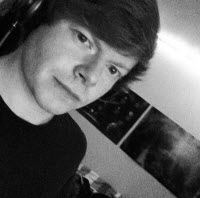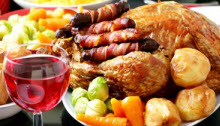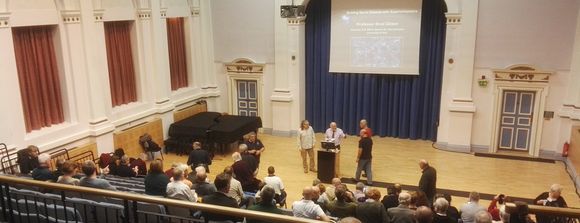Welcome to the WDAS monthly newsletter for December 2016: a digest of the month's latest contributions to our website. Below you'll find Society News, Sky Notes and In-Focus articles printed in full. There's also future events, and trailers for other articles which appear in full on the website - just a click away!
On the website you'll also be able to comment on articles, and if you'd like to play an editorial role in creating new content, just let us know!
Society News
Hi Everyone! I'm Andi. Some of you know me from the WDAS monthly meetings or Star Parties, but the WDAS Newsletter reaches a wider audience. I'm also part of your Newsletter team with Mark and Héctor. Héctor created this amazing website for you and he makes the newsletter work. Mark writes most of the articles for your pleasure and education, while I publish them on the web. But this article I'll write myself, because I want to introduce some regular new content to the WDAS website and ask you to consider supporting the work.
I'm not sure how many readers have watched Science and Astronomy content on YouTube, but it has to be the best place to learn on the planet. Hidden within the rants, product reviews, pranks and comedy; many wonderful and dedicated people are devoted to making superbly researched and produced educational videos. Here are a few of my favourite channels:
- Minute Physics: theoretical physicist Henry Reich explains fascinating and mind-bending facts about Science and the Universe short animations. And Henry's colleagues make a sister channel, Minute Earth.
- Fraser Cain: publishes the best on-line news source for Astronomers: "Universe Today", and his YouTube channel explains aspects of Astronomy every week.
- Deep Sky Videos: one of several channels made by Brady Haran and Astronomers & Physicists at Nottingham University. This channel has fascinating stories about Messier objects and tours of the world's biggest telescopes.
- PBS Space Time: favourite of hard-core cosmology fans, this channel is the place to be if you want to really understand how the Universe works as Einstein did.
These channels are labours of love and dedication by their intrepid creators, whose dedication in teaching the world can be a full-time job. They can only do their great work with some financial support. And the best way the internet has so far found to do that is to for some of the millions who benefit from the knowledge to make some trivial monthly contribution. All these content creators fund themselves (in whole or part) through a scheme called "Patreon". Here's the deal: a few hundred people who give a dollar or two per month (sorry, yes, it's always in dollars) can support science education viewed by millions. It's a trivial contribution, yet if we don't throw the odd coin in the hat, that great education resource will be snuffed-out.
Well, here's some great news: there are plenty of science-fans to spread around support so we can choose a channel or two to support.

UK Astrophysicist Sebastian
Pines, creator of 'Astronomic'
YouTube channel.
I'm going to make a case for some WDAS Members to support a new channel called 'Astronomic' by a young British Astrophysicist called Sebastian Pines. Here's a chance to make a big difference, because Seb has the great skill of explaining stellar mysteries in a stream of succinct videos. It takes lots of time to build up a support base, and unlike the channels I mentioned that already have hundreds of supporters, Astronomic is just starting out. You can check out some of his videos... I listed just a few of them below:
- Can we see black holes?
- What are brown dwarfs?
- Where did the Big Bang happen?
- Can a moon have a moon?
- Why is the Sunset red?
- Why is the earth round?
- Do galaxies die?
- Schrodinger
By supporting 'Astronomic', you'll get to see how Sebastian develops the channel, and you can have your name listed as a supporter on his videos! I'm also going to post one or two of the Astronomic videos on WDAS each month, which will be included in the newsletter along with the video transcript. So it's kind of a way to support WDAS too!
If you're up for that, here's a link to Astronomic's Patreon page.
This month's video from Astronomic...
In theory, a moon can have a moon. The region of space around a satellite where a sub-satellite can exist is called a 'Hill sphere'. Outside the Hill sphere the sub-satellite would be lost around the satellite, and therefore orbiting the planet or the sun instead of the moon itself.
An easy example of this is the Sun, Earth, Moon system. Earth is a satellite of the Sun, and the Moon is a sub-satellite of the Earth. The Moon orbits the Earth because the earth is about 380,000km (237,000 miles) from the Earth. This is well within the Hill sphere of the Earth, which has a radius of 1.5m km.
The Hill sphere is basically the space where Earth's gravity is more important than the Sun's gravity to another object. If the Moon somehow ended up outside the Hill sphere of the Earth, the Moon would orbit around the Sun instead of the Earth - just like all the other planets, asteroids and comets.
Jupiter's Hillsphere is much larger than the Earth. That's partly because it has more mass and more gravitational gravitational pull, but especially because it is further away from the Sun, so the Sun's gravity is much weaker at Jupiter than at Earth. This Jupiter a much bigger gravitational influence - one reason why Jupiter has a lot of moons. Not only has it got a big Hill radius, but it's also far enough from the Sun to have its own gravitational dominance.
So if we look at the Earth's Moon, it could have a sub-satellite. The Moon has its own Hill sphere with a radius of 67,000km (37,000 miles). This is where the sub-satellite could exist. If an object lies outside of the Hill sphere of the Moon it would therefore orbit the Earth instead of the Moon.
The only problem is that the sub-satellite cannot stay in orbit around the Moon because of tides. Like almost all the moons in the solar system, our Moon has a synchronous rotation (ie. they have the same face to their planet at all times). This results on tidal forces between the Earth and Moon... the same tidal forces that cause high/low tides on Earth. So any sub-satellite orbiting the Earth would have its orbit decay until eventually the sub-satellite would crash into the Moon or until be pulled apart by the Moon's tidal forces.
But in principle, the maths show that a Moon can have a Moon as long as certain
conditions are met.
 As of going to press, 8 people have so far booked for the society Christmas meal at the Hare and Hounds on Friday 9th. Menus choices must be made by December 6th - the night of our monthly meeting, which is the cut off date for anyone wishing to book a seat at the festive table. Travelling arrangements will be finalised then. The meal has been provisionally booked for 19:30h. The menu is on the website. If you could let Mark your choices as soon as possible it would be much appreciated.
As of going to press, 8 people have so far booked for the society Christmas meal at the Hare and Hounds on Friday 9th. Menus choices must be made by December 6th - the night of our monthly meeting, which is the cut off date for anyone wishing to book a seat at the festive table. Travelling arrangements will be finalised then. The meal has been provisionally booked for 19:30h. The menu is on the website. If you could let Mark your choices as soon as possible it would be much appreciated.
May 9th has been pencilled in for Paul’s lecture. The topic has yet to be decided, and the venue, but apart from that everything is going to plan.
We have been invited once again to assist with the Schools star night activities. The event is some way off, but the date for the diary is March 22nd – 19:00h. The York planetarium will be present, and hot soup, rolls and cakes will be available. Should be a good evening!
Five society members, Andi, Andy, Lee, Mark and John from Westerdale made the journey over to Leeds Astromeet this year. With Andi at the helm, we seemed to make good time, arriving at the venue with almost half an hour to spare before the first lecture. Parking proved more complicated than usual, with free ‘on street’ parking, off limits, replaced by ‘not so free’ ‘round the back’ car parking, admittedly at a reduced ‘coded’ rate to those attending the Astromeet.

Once inside the hall there was time enough to peruse the trade rooms. Two minutes later...yes, it has to be said, traders were sparse, somewhat disappointing, but on the other hand several purchases were made before the first lecture, real bargains too!
The lectures themselves will be covered in the January issue, suffice to say there was general agreement in the car on the way back, that they were better than last year, causing great debate amongst us.
As usual, dinner was spent in the student’s union complex. Construction work was very evident wherever we went. Leeds Uni is currently undergoing a £520 million pound facelift and expansion. Fortunately the cost of dinner hadn’t gone up to help pay for this, it came in at around a fiver.
The afternoon session seemed to fly by, especially for anyone who nodded off. As is customary Dr Alan Chapman drew the raffle before his talk. Prizes were not as bountiful or generous due to the lack of traders, however of the eight or so prizes on offer Andi/Andy won two, Mark won another and we almost won a further two, one number out. In fact most of the numbers drawn were between 990 and 1000, mirroring the numbers of our tickets.
Slightly embarrassing, our row was up and down like a yoyo. Our loot included a 3.2mm Bader eyepiece, a book, which bizarrely Mark had already bought earlier, and a disk about the Higgs Bosson particle. How strange?
The homeward journey was plagued by fog, which grew ever denser as we neared, and then passed Pickering. Fortunately, on reaching Saltersgate we ran out of it, and skies cleared somewhat. Another astromeet done and dusted, let’s hope that next year more traders attend.
Cosmology Corner
In theory, a moon can have a moon. The region of space around a satellite where a sub-satellite can exist is called a hillsphere. Outside the hillsphere the sub-satellite would be lost around the satellite, and therefore orbiting the planet or the sun instead of the moon itself.
An easy example of this is the Sun, Earth, Moon system. Earth is a satellite of the Sun, and the Moon is a sub-satellite of the Earth. The Moon orbits the Earth because the earth is about 380,000km (237,000 miles) from the Earth. This is well within the Hillsphere of the Earth, which has a radius of 1.5mkm.
A Hillsphere basically defines as the space where the Earth's gravity is more important than the Sun's gravity to another object. If the Moon somehow ended up outside the Hillsphere of the Earth, the Moon would orbit around the Sun instead of the Earth - just like all the other planets, asteroids and comets.
Jupiter's Hillsphere is much larger than the Earth. That's partly because it has more mass and more gravitational gravitational pull, but especially because it is further away from the Sun, so the Sun's gravity is much weaker at Jupiter than at Earth. This Jupiter a much bigger gravitational influence - one reason why Jupiter has a lot of moons. Not only has it got a big Hill radius, but it's also far enough from the Sun to have its own gravitational dominance.
So if we look at the Earth's Moon, it could have a sub-satellite. The Moon has its own hillsphere with a radius of 67,000km (37,000 miles). This is where the sub-satellite could exist. If an object lies outside of the Hillsphere of the Moon it would therefore orbit the Earth instead of the Moon.
The only problem is that the sub-satellite cannot stay in orbit around the Moon because of tides. Like almost all the moons in the solar system, our Moon has a synchronous rotation (ie. they have the same face to their planet at all times). This results on tidal forces between the Earth and Moon... the same tidal forces that cause high/low tides on Earth. So any sub-satellite orbiting the Earth would have its orbit decay until the sub-satellite crashed into the Moon or until it was pulled apart by the Moon's tides.
But in principle, the maths show that a Moon can have a Moon as long as certain
parameters are obeyed.


